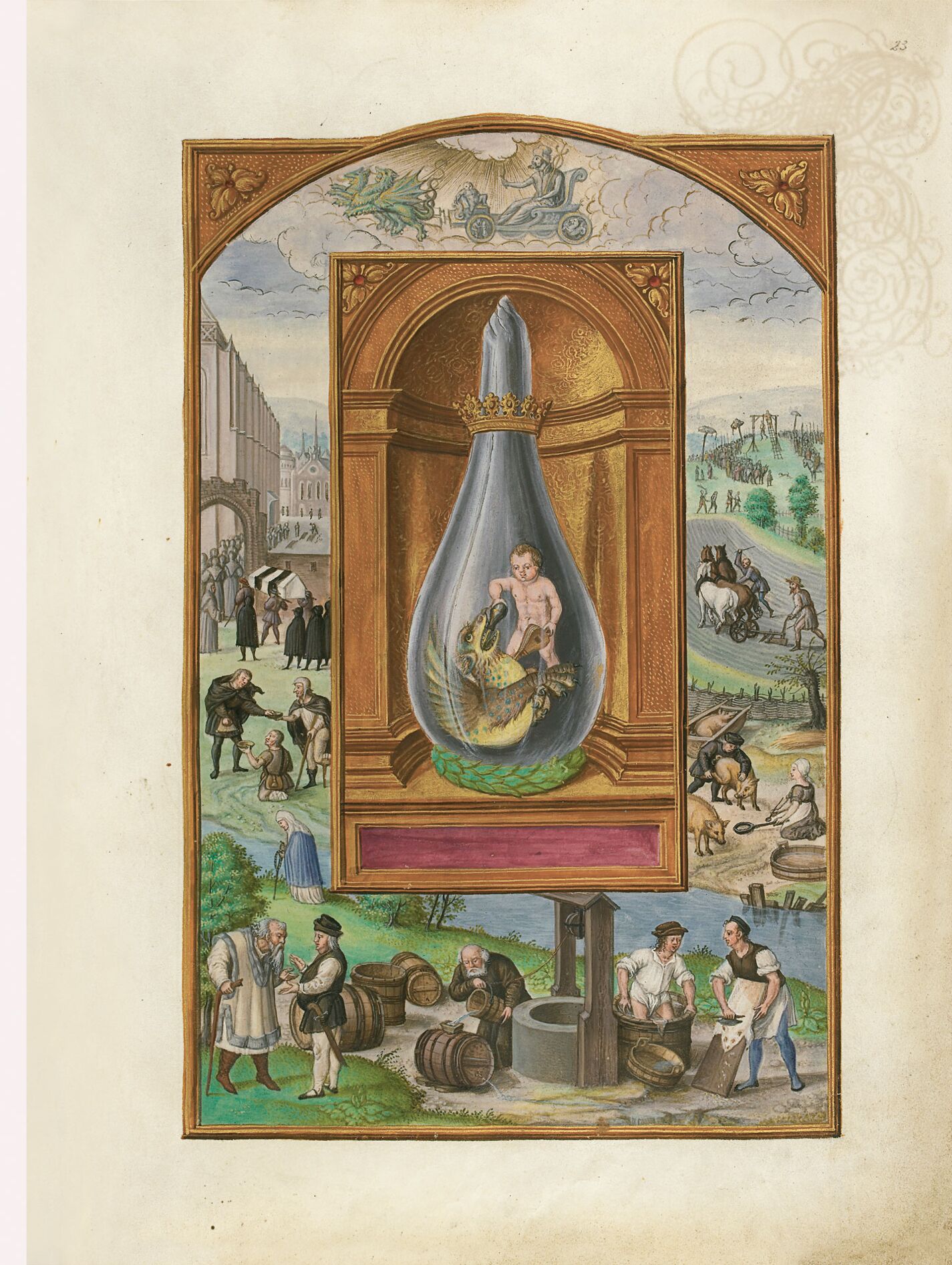Cast in monochrome shades of grey, the planetary god Saturn rides across the sky in his open chariot. He is drawn by two gold-embellished, green dragons. In his right hand Saturn holds a sickle; leaning against his left shoulder is a caduceus, the snake staff typically held by his colleague Mercury. This confusing detail is explained by Hartlaub as having to do with the fact that “… at times, common mercury, and at times lead (= Saturn) is nominated as the base material of alchemy.” Down on the ground the so-called “children of Saturn” are engaged in agricultural labour and are exposed to physical exertion and death. The flask standing on a green laurel wreath at the centre of the inserted panel contains a little boy who is pouring golden liquid from a bottle into the thirsty mouth of a blue-spotted dragon. At the same time he is pumping air at the dragon with a hand bellows.
Lead, which is attributed to the planet Saturn, is regarded as the basest of metals. As such, it constitutes the starting point of metal refinement. Symbolising the prime matter, or prima materia, of alchemy, the dragon is a pendant to lead. An earlier depiction of a dragon in a glass vas hermeticum in the Donum Dei served as the reference for this illustration in the Splendor Solis. The feeding of the dragon which, akin to the fire-fanning bellows, represents the alchemical method of heating by fire, is also mentioned in the golden inscription in the colour cartouche of the Nuremberg manuscript of the Splendor Solis (Germanisches Nationalmuseum, Hs. 146 766): “Draconem nostrum mortuum sanguine construite ut vivat ” (Fortify our dead dragon with blood, that he might live). Related inscriptions, most likely added by a different hand at some later point, can also be found in the other “planet-children” miniatures, albeit only in the Nuremberg manuscript. Insofar as these inscriptions offer something of a primary insight into possible interpretations, it seems prudent to cite them in the commentaries below.

Cast in monochrome shades of grey, the planetary god Saturn rides across the sky in his open chariot. He is drawn by two gold-embellished, green dragons. In his right hand Saturn holds a sickle; leaning against his left shoulder is a caduceus, the snake staff typically held by his colleague Mercury. This confusing detail is explained by Hartlaub as having to do with the fact that “… at times, common mercury, and at times lead (= Saturn) is nominated as the base material of alchemy.” Down on the ground the so-called “children of Saturn” are engaged in agricultural labour and are exposed to physical exertion and death. The flask standing on a green laurel wreath at the centre of the inserted panel contains a little boy who is pouring golden liquid from a bottle into the thirsty mouth of a blue-spotted dragon. At the same time he is pumping air at the dragon with a hand bellows.
Lead, which is attributed to the planet Saturn, is regarded as the basest of metals. As such, it constitutes the starting point of metal refinement. Symbolising the prime matter, or prima materia, of alchemy, the dragon is a pendant to lead. An earlier depiction of a dragon in a glass vas hermeticum in the Donum Dei served as the reference for this illustration in the Splendor Solis. The feeding of the dragon which, akin to the fire-fanning bellows, represents the alchemical method of heating by fire, is also mentioned in the golden inscription in the colour cartouche of the Nuremberg manuscript of the Splendor Solis (Germanisches Nationalmuseum, Hs. 146 766): “Draconem nostrum mortuum sanguine construite ut vivat ” (Fortify our dead dragon with blood, that he might live). Related inscriptions, most likely added by a different hand at some later point, can also be found in the other “planet-children” miniatures, albeit only in the Nuremberg manuscript. Insofar as these inscriptions offer something of a primary insight into possible interpretations, it seems prudent to cite them in the commentaries below.